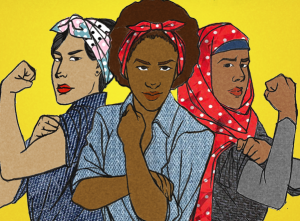Originally published on The Body Is Not An Apology, and republished here with their permission.

A couple outdoors smiling as they gaze into the camera.
Not to brag, but my wife’s birthday was earlier this month and I got her an incredible gift. A month or two earlier, she had passively mentioned that she really liked the thought of getting a record player, and had separately said that she was tired of our listening to music on our phones while chilling out in our apartment.
My solution was acquiring a sweet audio system that included a record player, CD player, radio, and AUX input. She cried; that’s how well it went over.
The next day, we decided to try it out, plugging in my phone to listen to a little Christina Aguilera while she shopped online for vinyl. I hopped in ready to direct the whole operation of setting up cables and dials despite the fact that it was her gift, which she wanted to figure out.
Her response to me more-or-less amounted to “Darling, stop being such a dude about this.”
Those aren’t comfy words for me to hear. They flash me back to my father taking building projects and maintenance tasks out of my hands because I was his very non-masculine son who clearly wouldn’t be able to handle that sort of work.
My reaction, the only appropriate reaction, was an apology. I backed off and went back to my writing because while my wife doesn’t have my years of A/V training or experience with complicated electronics or any of my other personal traits that sprang to my mind as counter-arguments, she doesn’t need them to set up a basic audio device.
It just isn’t that complicated. She did just fine with it and I’m still listening to Christina even as I write this (Back to Basics is a tragically underrated album, by the way).
1. Dividing Up Household Tasks
Both of us grew up with decently traditional gender roles presented in our families. We had fathers who lectured and fixed things and were at times stingy with money and affection. We had mothers who coddled and did most of the cooking and at times didn’t work while their husbands did, despite being arguably more qualified or educated.
When I initially sat down to ponder where we as a dedicatedly progressive couple have diverged our relationship dynamics away from these influences, I realized that a lot of the discussion seems to be tied to very surface-level matters, or at least that my instincts jump there.
It can be easy to look at a heteronormative couple and say that because the husband does most of the cooking or where the wife makes the bulk of the money (two truths of our household), that they’re a lot more enlightened or advanced than their forebears.
Unfortunately, it’s rarely that easy. A couple can trade domestic tasks all that they want, but that doesn’t mean that a husband has let go of the societal expectation to be a “head of household” and all of the toxic elements that coincide with that.
It doesn’t mean that a wife has completely purged all internalized signals that growing up in a patriarchy seeds into her, that she should defer and be demure, that her well being should be the first sacrifice made for the maintenance of a happy home.
Do not misunderstand: the division of tasks is important because the macro-environment is absolutely made up of the micro-environment. Unlike a home in which factors like availability of time, opportunity, knowledge, or physical ability dictate tasks, one in which day-to-day burdens are left unexamined and divided by gender are inherently unequal.
I would never want to discount couples with a stay-at-home parent for instance, especially when childcare can cost almost as much as some working adults make in a year, so long as it a deliberate choice made by both individuals on the basis of facts and not societal expectation. This lack of consideration can seep into other parts of the relationship, and inequality becomes much easier to allow because it exists at the most basic level.
This was one of the easier splits for my wife and I: we divide most chores pretty much down the middle with the other stepping up when there is a deadline or an illness or other obstacle. She does the dusting because she hates the laundry and I do the laundry because I hate the dusting. These are the least complicated of our compromises.
2. Recognizing and Deconstructing Women’s (Emotional) Work
Once a couple moves past this initial question, the analysis of deeper issues can be made. I mentioned earlier, for instance, that both my father and my father-in-law were explanatory types. Even in my late twenties, I’m careful about what problems I present to my father on our regular phone calls mostly because I dread opening a Pandora’s Box of unsolicited advice and the choice to either rudely cut the conversation short or simply tune him out for the requisite ten minutes (minimum) he’ll take.
This was the well-intentioned but very patriarchal being I channeled in wanting to help my wife with her record player. This was the compulsion that I needed to have her point out so that I could collect myself and course correct rather than continue an egotistical and largely gendered cycle.
A more important angle of this is what my wife deals with as a woman in a heteronormative marriage. We dated for the better part of a decade before actually getting married, so I had a delightfully infuriating front-row seat to all of the instances in which friends, family, and perfect strangers asked her (not me) when we were going “seal the deal,” “take the plunge,” “get on with it,” etc.
She herself admitted that my proposal was a relief of sorts to her, though we both have agreed that had we attempted to marry earlier, we probably would not have been as strong as we are now.
The funny part about the pressures associated with gender roles is that they don’t really go away once you follow the path they’ve been specifying for so long – they simply shift. Marriage is emphasized as an end goal in so many narratives, especially for women, and what follows is not the release of a “happily ever after,” but rather the new constraints of marital expectations.
Whether it’s the Bible or an episode of The King of Queens, wives are expected to be the endlessly patient and supportive partners as their husbands do the important stuff. That is the story and our internalization of it can lead to debilitating shame. Even moving past the obviously outdated belief that a wife must be a housemaid or cook in her household, there is still the expectation to a cheerleader, a sex kitten, even a motherly coddler.
3. Creating a Partnership of Equals
The most radical act of subverting gender roles in my marriage is the staunchness with which we treat our partnership as one of equals – with which we remain individual. Many couples call themselves partners with too little regard for what true partnership looks like. It is being a pair of individuals who work together, rather than being some machine made of two parts that must each perform certain tasks within the mechanism to function.
We all make our happy awww noises when couples say during their weddings and their anniversary dinners that their partner is the rock upon which they’ve built their lives. If this is a poetic nicety, there’s no harm in it. If the metaphor is too applicable though, extending beyond simply emotional truth, there’s a problem.
The husband who says this of his wife is possibly relying on her ingrained roles at her own expense. The wife who says this of her husband may be allowing him to indulge himself in a dominant, often toxic role as head of their lives.
By being individual, however, keeping our mental well-being a priority, our self-love and self care and individual experiences, we can better function as a couple. A true partnership has no mechanical designations for roles and duties; it is a pair of self-aware people working and struggling to bolster one another, rather than sinking to hold afloat the other.
Challenging gender roles has much less to do with trading stereotypical expectations and more to do with throwing them out entirely. And sad as it may be, it’s possibly the most difficult (though worthwhile) challenge a marriage can take on.
[do_widget id=’text-101′]
Search our 3000+ articles!
Read our articles about:
Our online racial justice training
Used by hundreds of universities, non-profits, and businesses.
Click to learn more




















